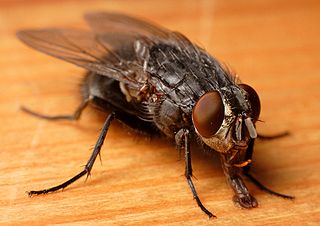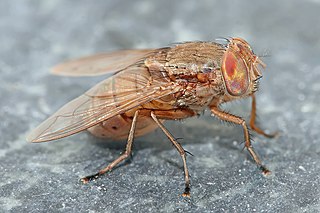
The Calliphoridae are a family of insects in the order Diptera, with almost 1,900 known species. The maggot larvae, often used as fishing bait, are known as gentles. The family is known to be polyphyletic, but much remains disputed regarding proper treatment of the constituent taxa, some of which are occasionally accorded family status.

Cluster flies are flies of the genus Pollenia in the family Polleniidae. Unlike the more familiar blow flies, such as the bluebottle genus Phormia they do not lay eggs in human food. They parasitise earthworms; the females lay their eggs near earthworm burrows, and the larvae then feed on the worms. But the biology of this group is relatively poorly known and a few have been recorded from other hosts including caterpillars and bees.

Calliphora is a genus of blow flies, also known as bottle flies, found in most parts of the world, with the highest diversity in Australia. The most widespread species in North America area Calliphora livida, C. vicina, and C. vomitoria.

Bengalia is a genus of blow flies in the family Calliphoridae with one authority considering the genus to belong to a separate family Bengaliidae. These bristly and, unlike the greens and blues of most calliphorids, dull coloured flies, are especially noted for their relationship to ants. Little is known of their biology and life-cycle, although adults of many species are kleptoparasitic on ants and will snatch food and pupae being carried by ants or feed on winged termites. The apt name “Highwayman Fly” was given by an early observer of their way of robbing ants. Very little is known about their breeding habits. The genus is found in the Afrotropical and oriental region with one species from Australia possibly a recent introduction.

Melinda is a genus of flies in the family Calliphoridae. In general little is known of their biology. A few species have been reared from snails. One – Melinda gentilis – is parasitic in the snails Helicella virgata and Goniodiseus rotundata and Melinda itoi is a parasite of the snail Acusta despecta sieboldiana.

Linnaemya is a genus of flies in the family Tachinidae.

Lophosia is a genus of flies in the family Tachinidae.

Tachininae is a subfamily of flies in the family Tachinidae.
Cosmina is a genus of flies in the family Rhiniidae.

Polleniidae is a family of flies in the order Diptera. There are at least 6 genera and more than 190 described species placed definitively in Polleniidae, and other genera whose placement here is considered uncertain. The largest genus is Pollenia, with close to 190 species of flies commonly called "cluster flies".

Rhiniidae is a family of flies in the order Diptera, and formerly included in the Calliphoridae. There are around 30 genera and 370 described species in Rhiniidae.
Xanthotryxus is a genus of flies in the family Polleniidae.
Morinia is a genus of flies in the family Polleniidae.
Dexopollenia disemura is a species of cluster fly in the family Polleniidae.
Dexopollenia yuphae is a species of cluster fly in the family Polleniidae.
Dexopollenia fangensis is a species of cluster fly in the family Polleniidae.
Dexopollenia flava is a species of cluster fly in the family Polleniidae.
Dexopollenia luteola is a species of cluster fly in the family Polleniidae.
Dexopollenia maculata is a species of cluster fly in the family Polleniidae.
Dexopollenia uniseta is a species of cluster fly in the family Polleniidae.









